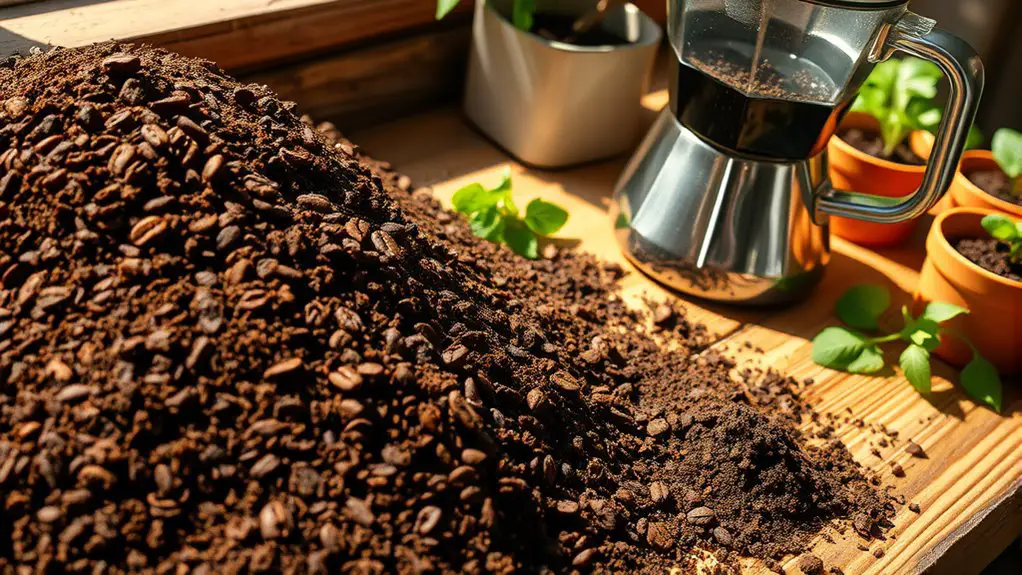To make compost from used coffee grounds, start by brewing your coffee as usual and allowing the grounds to cool. Once cooled, scoop them into a compost bin. Mix the grounds with carbon-rich materials like dried leaves or straw, maintaining a ratio of one part grounds to three parts carbon. Be sure to turn your compost regularly and monitor moisture levels for the best results. Stick around to discover more tips for successful composting with coffee grounds!
Understanding the Benefits of Coffee Grounds in Composting
When it comes to composting, coffee grounds are a hidden gem that can greatly enhance the quality of your compost. Rich in nitrogen, they provide a fantastic nutrient boost, making your compost pile more effective at breaking down organic materials. When you mix coffee grounds into your compost, you're not just adding nutrients; you're also improving soil texture and aeration. This soil enhancement encourages beneficial microorganisms, which play a key role in creating healthy soil. Plus, coffee grounds can help balance the carbon-to-nitrogen ratio in your compost, making it more efficient. So, if you want to create nutrient-rich compost that leads to thriving plants, don't underestimate the power of those used coffee grounds in your gardening journey!
How to Collect and Prepare Used Coffee Grounds
Collecting and preparing used coffee grounds is a simple yet effective process that anyone can do. Start by brewing your favorite coffee as usual. Once you're done, let the grounds cool before handling them—this makes collecting grounds easier. Use a spoon or spatula to scoop out the used coffee grounds from the filter or pot. You can also pour them into a compost bin or bucket for easier access. If you're preparing materials for your compost, make sure the grounds are dry before adding them. Storing them in a sealed container helps keep them fresh until you're ready to use them. With just a little effort, you're on your way to creating rich compost that benefits your garden.
Combining Coffee Grounds With Other Compost Materials
Now that you've gathered your used coffee grounds, it's time to think about how to combine them with other compost materials for ideal results. Coffee grounds are rich in nitrogen, which is essential for a healthy compost pile. To maintain a proper nitrogen balance, layer your grounds with carbon-rich materials like dried leaves, straw, or shredded paper. Use layering techniques to alternate between green (nitrogen) and brown (carbon) materials, ensuring an even distribution. This approach not only enhances decomposition but also prevents odor and pests. Aim for a mix of about one part coffee grounds to three parts carbon materials. By thoughtfully combining your grounds, you'll create nutrient-dense compost that supports flourishing plants and contributes to a sustainable lifestyle.
Tips for Maintaining Your Compost Bin
To guarantee your compost bin thrives, it's important to regularly monitor its conditions and make adjustments as needed. Here are some tips for effective moisture control and overall maintenance:
| Condition | What to Look For | Action to Take |
|---|---|---|
| Too Dry | Crumbly, dry texture | Add water or moist materials |
| Too Wet | Sour smell, slimy | Add dry materials like leaves |
| Balanced Moisture | Earthy smell, crumbly | Turn compost and maintain |
| Temperature | Warm to touch | Aerate the compost |
Regularly turning your compost bin not only aerates it but also helps maintain that perfect balance. You'll enjoy the freedom of knowing you're nurturing a rich, organic resource for your garden!
Using Your Finished Compost in the Garden
After nurturing your compost and ensuring its ideal conditions, it's time to put that rich, dark gold to work in your garden. Start with compost application by mixing it into your soil or using it as a top dressing for your plants. This natural fertilizer will provide essential nutrients, promoting healthier growth and stronger plants.
For soil enhancement, blend your compost with existing soil to improve its structure and increase moisture retention. Whether you're growing vegetables, flowers, or shrubs, your plants will thrive with this organic boost. Remember, a little goes a long way, so don't overdo it. Enjoy the freedom of gardening with your homemade compost, knowing you're enriching both your plants and the environment!
Frequently Asked Questions
Can I Use Flavored Coffee Grounds for Composting?
Yes, you can use flavored coffee grounds for composting. They still offer compost benefits, like improving soil structure and nutrient content. Just be mindful of any additives that might affect your compost's balance. Enjoy the process!
How Often Should I Add Coffee Grounds to My Compost?
You should add coffee grounds to your compost regularly, aiming for ideal amounts of about one part grounds to three parts browns. Following frequency guidelines helps maintain balance, ensuring your compost thrives and stays nutrient-rich.
Do I Need to Dry Coffee Grounds Before Composting?
You might think drying coffee grounds is essential, but it's not! Composting them fresh offers incredible benefits. Just mix them in, and if you prefer, use simple drying methods to enhance nutrient release. Freedom in composting awaits!
Can I Compost Coffee Filters Along With the Grounds?
You can definitely compost coffee filters along with the grounds! Coffee filter composting offers benefits like increased carbon content, which balances nitrogen-rich materials. Just make certain they're unbleached for the best results in your compost pile.
Are There Any Plants That Dislike Coffee Ground Compost?
Like a delicate dance between friends, some plants have coffee sensitivity. While many thrive on coffee ground compost, avoid using it with plants like rosemary or mint, which often prefer less acidic, richer soil.
